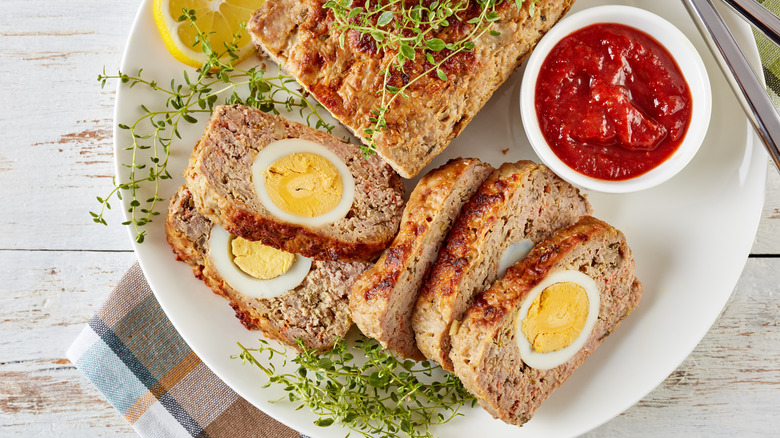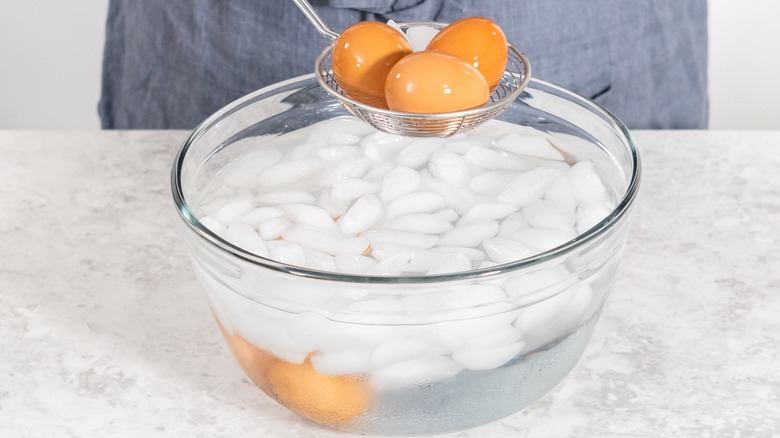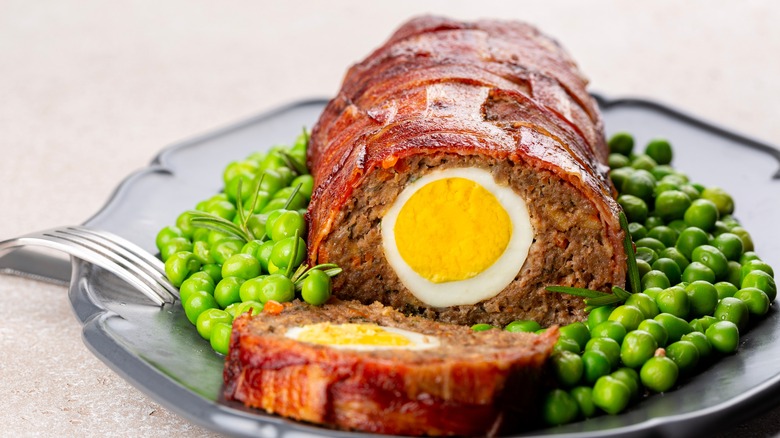Hard-Boiled Egg: The Ingredient That Surprisingly Elevates Meatloaf
The origins of some meatloaf variants can be traced back to the 5th Century when a Roman cookbook detailed the formation of meaty patties blended with bread and wine. Since this era, meatloaf has become a nostalgic dish that's made in a variety of ways. A classic beef meatloaf is delectably juicy, irresistibly savory, and rich with the essence of meaty goodness. Beyond this traditionally American rendition, however, is another version that incorporates the delightful addition of hard-boiled eggs and takes this humble classic to new heights.
Meatloaf can be incredibly dense, and hard-boiled eggs alleviate the concentrated meaty structure, providing a softer center that's just waiting to be savored. Hard-boiled eggs have a deliciously rich, buttery disposition, which pairs wonderfully with the profoundly savory nature of meatloaf. The slices of meatloaf centered with hard-boiled eggs make for an impressive appearance that is relatively easy to execute. It also adds a brilliant flash of color that breaks up the very monochromatic shade of meatloaf.
Hard-boiled eggs are the unexpected ingredient your meatloaf is just itching to hide. With a multitude of cultural variations to try, this dish is elevated in more ways than one.
The best-hard boiled eggs
An egg-stuffed meatloaf is exceptionally straightforward to create, but it's important to underline the potholes you want to avoid. Ensure the eggs are fully hard-boiled, which means no gooey centers. To shape the meatloaf over the top of the eggs, you want resistance from the eggs; otherwise, they could collapse, turning the meatloaf into a mess. For fully cooked yolks and firm whites, boil the eggs for 10 minutes. Be mindful that overcooked eggs will turn rubbery and dry, which is a possibility if you reach the 15-minute mark.
Cutting into an egg-stuffed meatloaf should be jaw-dropping, with the flawless circular shape of the egg suspended precisely in the center. To achieve this result, the eggs must be delicately peeled. There is no better way to accomplish this than by placing hard-boiled eggs in an ice bath after cooking. This reduces the chances that you break the circular structure of the egg white.
Older eggs are also easier to peel than fresh, although you should be sure to use them within a week of cooking, per the U.S. Food and Drug Administration (FDA). As an egg ages, the pH level inside rises and the inner shell membrane that's attached to the albumen (the egg white or protein) starts to weaken. Thus, it's easier to peel than a fresh egg, which has a stronger bond with the shell.
Various renditions
Meatloaf featuring hard-boiled eggs is enjoyed in various ways across Europe, lending itself to a range of different seasonings and toppings. In Poland, an egg-stuffed meatloaf named Pieczeń rzymska z jajkiem is typically served at Easter. It's made with ground pork, seasoned with marjoram, and brushed (before baking) with mustard or topped with bacon. Another seemingly Easter-inspired rendition of this dish is the false rabbit, or Falscher Hase in German. It became particularly popular for Sunday lunch in Germany during World War II when meat was scarce. The loaf is typically wrapped in bacon, and the hidden eggs inside are meant to surprise the guests it's served to.
In Italy, an egg-stuffed meatloaf is named Polpettone ripieno al Forno, which, although its bacon-wrapped exterior resembles these early interpretations, inside it's a different story. When preparing, the meatloaf is spread into one layer and topped with a layer of spinach, prosciutto cotto, and provola cheese before the eggs are placed on top, and the whole loaf is rolled together. As it turns out, the eggs aren't the sole surprise.
Hard-boiled eggs are a fantastic way to elevate a meatloaf, whether for the surprise that awaits once it's cut into or the buttery texture they add to each bite. It's worth a try.


